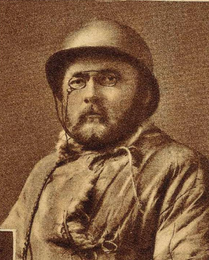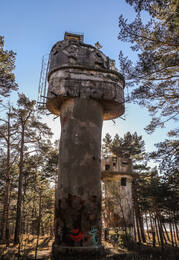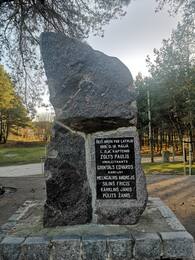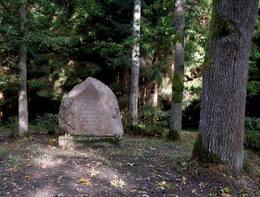Pietų Latvijos brigada arba Atskiroji Latvijos brigada
I Nepriklausomybės karai
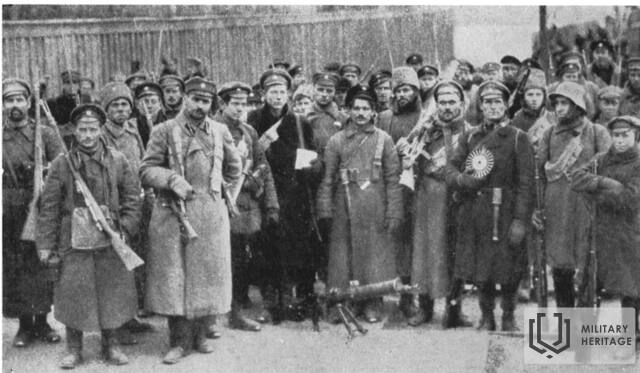
Pietų Latvijos brigada arba Atskiroji Latvijos brigada buvo Latvijos Landesveerio (Namo gvardijos) kariuomenės dalis, kuri po pergalės Cėsių mūšyje ir Strazdumuižos paliaubų 1919 m. liepos 10 d. buvo sujungta su Šiaurės Latvijos brigada ir Baltijos vokiečių Namo gvardija, sudarant Latvijos ginkluotąsias pajėgas (Latvijos armiją).
1919 m. kovo 21 d. Liepojoje Latvijos laikinosios vyriausybės saugumo ministras Jānis Zālītis išleido įsakymą Nr. 21, kuriuo Latvijos atskirasis batalionas buvo pervadintas į Latvijos armijos Pietų grupę, organizuojant atskirą brigadą iš pėstininkų kuopų, sapierių kuopą ir vadovaujantį artilerijos dalinį. Brigadai vadovavo Jānis Balodis, kuris šiuo įsakymu nuo kovo 14 d. buvo paaukštintas į pulkininkus.
Pietų Latvijos brigada toliau dalyvavo Kuržemės ir Žiemgalos išlaisvinime nuo bolševikų. 1919 m. gegužės 18 d. mūšyje prie Kaugurciemo kapitono Paulo Zolco kuopa privertė du bolševikų pulkus trauktis iš savo pozicijų, o dėl pergalės Latvijos atskirieji brigados daliniai išlaisvino dabartinės Jūrmalos teritoriją, o gegužės 22 d. brigada dalyvavo Pinkų išlaisvinime, o gegužės 23 d. įžengė į Rygą. Išlaisvinus Rygą, brigada toliau buvo pildoma naujais daliniais. Brigada tiesiogiai nedalyvavo Cėsių mūšiuose.
1919 m. liepą, suformavus vieningą Latvijos armiją, Pietų Latvijos brigada buvo pertvarkyta į Kuršo diviziją.
Daugiau informacijos šaltinių
Latvijos laikinosios vyriausybės saugumo ministro J. Zālīčio įsakymas (Nr. 21) dėl generolo J. Baložo patvirtinimo Latvijos atskirojo bataliono vadu ir jo pervadinimo į Latvijos armijos Pietų grupę. https://web.archive.org/web/20070531202113/http://www.historia.lv/alfabets/L/la/lat_atsev_bat/dok/1919.03.21.htm
Pietų Latvijos brigada. Vikipedija. https://lv.wikipedia.org/wiki/Dienvidlatvijas_brig%C4%81de
Ērikas Jėkabsonsas. Latvijos nepriklausomybės karas. Latvijos laikinosios vyriausybės ir jos ginkluotųjų pajėgų kova už Latvijos nepriklausomybę nuo 1918 m. lapkričio 18 d. iki 1920 m. rugpjūčio 11 d. – Nacionalinė enciklopedija: https://enciklopedija.lv/skirklis/22216-Latvijas-Neatkar%C4%ABbas-kar%C5%A1
Kova už laisvę: Latvijos nepriklausomybės karas (1918–1920 m.) Latvijos valstybinio istorijos archyvo dokumentuose, 1 dalis, 1918 m. lapkričio 18 d. – 1919 m. balandžio 16 d., sudar. Ē. Jēkabsons ir J. Šiliņš, Ryga, Latvijos nacionalinis archyvas, 2019 m.
„Kova už laisvę: Latvijos nepriklausomybės karas (1918–1920 m.) Latvijos valstybinio istorijos archyvo dokumentuose“, 2 dalis. 1919 m. balandžio 16 d. – liepos 10 d., sudar. Ē. Jēkabsons ir J. Šiliņš, Ryga, Latvijos nacionalinis archyvas, 2019.
Susijusios vietos
LKOK kapitono Paulo Zoltso individualus palaidojimas Mazsalacos kapinėse
Įsikūręs Mazsalacos kapinėse.
Galima apžiūrėti kapitono Paulo Zoltso (1880–1919) individualias palaikas.
1934 m. rugsėjo 9 d. ant Zoltso kapo buvo atidengtas juodo granito antkapis su tekstu.
Kapitono Zoltso vardas taip pat iškaltas ant paminklo Kaugurcieme, kur 1919 m. gegužės 18 d. mūšyje žuvo iš viso šeši atskirojo studentų bataliono 2-osios, arba P.Zoltso kuopos, kareiviai.
Latvijos atskirosios brigados atskirojo studentų bataliono 2-osios kuopos vadas kapitonas Paulis Zoltsas, žuvęs netoli Kaugurciemo 1919 m. gegužės 18 d., iš pradžių buvo palaidotas brolijos kapinėse netoli Kemeri liuteronų bažnyčios. 1920 m. gegužės 18 d. jo palaikai buvo ekshumuoti ir perkelti į Mazsalacą, kur gegužės 25 d. palaidoti šeimos kapinėse.
Karosta, Liepojos karinis uostas (ekskursija)
Karosta yra didžiausia istorinė karinė teritorija Baltijos šalyse ir užima beveik trečdalį visos Liepojos teritorijos. Karosta – unikalus karinių ir įtvirtinimų pastatų kompleksas Baltijos jūros pakrantėje, turintis ypatingą reikšmę Latvijos ir pasaulio istorijoje bei architektūroje. Karostoje yra tokie karinio paveldo objektai kaip Šiaurinis molas ir fortai, Redanas, Karostos kalėjimas, Karostos vandens bokštas, Šv. Nikolajaus stačiatikių Jūros katedra, Oskaro Kalpako tiltas ir kiti.
Paminklas kapitonui Zoltui ir studentams kareiviams
Įsikūręs Jūrmalos mieste, Slokoje, prie Rygos įlankos, Kaugurciemo kopose.
Memorialas pastatytas 1934 m., sunaikintas sovietų okupacijos metu, bet atstatytas 1989 m. Kaugurcieme, 1919 m. gegužės 18 d. rytą, įvyko mūšis tarp Latvijos nacionalinių pajėgų, kapitono Paulio Zoltso vadovaujamos kuopos (apie 145 vyrų), ir Raudonosios armijos karių. Šis įvykis ypatingas tuo, kad mūšis vyko pačiomis nepalankiausiomis sąlygomis, demonstruojant karinę drąsą ir tikėjimą Latvijos valstybe.
Naktį prieš mūšį kilo audra, kurios pozicijos ir ginklai buvo uždengti smėliu. Be to, buvo gauta nepakankamai amunicijos. Priešui puolant, kapitono Zolco kareiviai lemiamu momentu kontratakavo, panaudodami šautuvų durtuvus ir iškovodami pergalę.
Zoltsas buvo patyręs Latvijos karininkas, dalyvavęs Rusijos-Japonijos kare, Pirmajame pasauliniame kare ir Latvijos nepriklausomybės kare. Jo brolis taip pat buvo kareivis, o sūnus, studijuodamas mediciną Antrojo pasaulinio karo metu, buvo Vokietijos armijos Latvijos legiono medikas ir krito nešdamas sunkiai sužeistą kareivį iš savo pozicijų.
Šiandien galite aplankyti mūšio vietoje pastatytą memorialinę vietą. Netoliese yra gražus pajūrio miškas ir jūra, leidžianti malonioje aplinkoje susipažinti su istorija.
Atminimo akmuo generolo Janio Baložo brigados mūšio vietoje
Atminimo akmuo generolo Janio Baložo brigados mūšio vietoje yra miške netoli Rygos–Liepojos (A9) greitkelio, šalia Batarų namo.
Atminimo akmuo buvo atidengtas 1936 m. iškilmingoje ceremonijoje, kurioje dalyvavo tuometinis susisiekimo ministras B. Einbergas ir kiti aukšti Rygos pareigūnai bei Džūkstės parapijos visuomenė, minint 1919 m. kovo 22 d. čia įvykusį mūšį. Ant paminklo iškaltas užrašas: „Čia 1919 m. kovo 22 d. įvyko 1-osios atskirosios Baložių brigados mūšis, kuriame žuvo 10 ir buvo sužeisti 28 kareiviai.“
Mūšis vyko tarp Atskirosios Latvijos brigados ir 10-ojo sovietų Latvijos šaulių pulko, kuriame 90 procentų buvo latviai. Laisvės kovų metu tai buvo vienas iš tų mūšių, kuriuose latviai kovojo su latviais. Bolševikai buvo įsitvirtinę Batarų namuose. Jie pradėjo apšaudyti brigados kareivius, einančius Kalnciemo kryptimi. Ugniai stiprėjant, brigada išsidėstė kovai. Pagrindinė mūšio našta teko Atskirajai Studentų kuopai ir Latvijos nepriklausomybės batalionui. Mūšiui užsitęsus, studentų kuopos būrys ir naujai suformuota kapitono E. Graudinio kuopa, atlikdami apėjimo manevrą, miške susidūrė su priešu, kuris atliko panašų manevrą. Įnirtingoje kovoje, kuri kai kuriose vietose virto artima kova, priešas buvo nugalėtas. Tuo metu brigadai priskirta vokiečių Millerio baterija atidengė ugnį į Batarų namus. Po artilerijos ugnies brigada greita ataka išstūmė priešą iš jo pozicijų.
Laikraštis „Brīvā Zeme“ (1936 m. gegužės 18 d.) paskelbė buvusio kovotojo prisiminimus: „Brigadavos kavalerija ką tik buvo išjojusi į atvirą lauką, kai juos pasitiko smarki priešo ugnis. Po to tapo aišku, kad jie susiduria su labai stipriomis priešo pajėgomis. Batalionai, generolo J. Baložo įsakymu, išsidėstė ir pradėjo kovoti, įsitraukdami į artimą kovą, nes brigados kareivių durtuvai šį dviejų valandų mūšį pavertė spindinčia kalpakiečių pergale. Šis mūšis buvo labai svarbus, nes sulygino padėtį fronte, kuris tapo nesaugus dėl vokiečių, ir užtikrino, kad raudonųjų šaulių pulkai nebepatektų į Žiemgalos lygumą.“
Generolo J. Baložo brigada laimėjo mūšį, pralaimėdama 10 kareivių, tarp jų – Kārlį Baroną (1900.8.III – 1919.22.III), Dainų tėvo Krišjanio Barono anūką, palaidotą Rygos brolių kapinėse. Mūšyje žuvo 50 sovietinio Latvijos šaulių pulko kareivių.
Susijusi istorija
Cėsių mūšio pradžia, eiga ir pabaiga
Pergalė Cėsių mūšyje turėjo tapti lūžio tašku Latvijos ir Estijos kovoje už savo šalies nepriklausomybę. Ši pergalė sustabdė Andrijevo Niedros vyriausybės ir vokiečių generolo Rüdigerio fon der Golco planus užkariauti Pabaltijį. Vietoj to, Liepojoje savo veiklą atnaujino Karlio Ulmanio vadovaujama Laikinoji Latvijos vyriausybė.
Apie pirmąjį Latvijos armijos vyriausiąjį vadą Dāvidą Sīmansoną
Knygos „Latvijos armijos vadai“ esė įtikina, kad istorijai didelę įtaką daro konkretūs asmenys. Nors svarbiausių istorinių įvykių epicentre jie buvo trumpą laiką, tikri Latvijos patriotai, turėdami didelę karinę patirtį, sugebėjo daug nuveikti formuojant ir stiprinant Latvijos kariuomenę bei istorinių įvykių lūžio taškuose.
Ši istorija yra apie pirmąjį Latvijos armijos vyriausiąjį vadą Dāvidą Sīmansoną (1859–1933).





